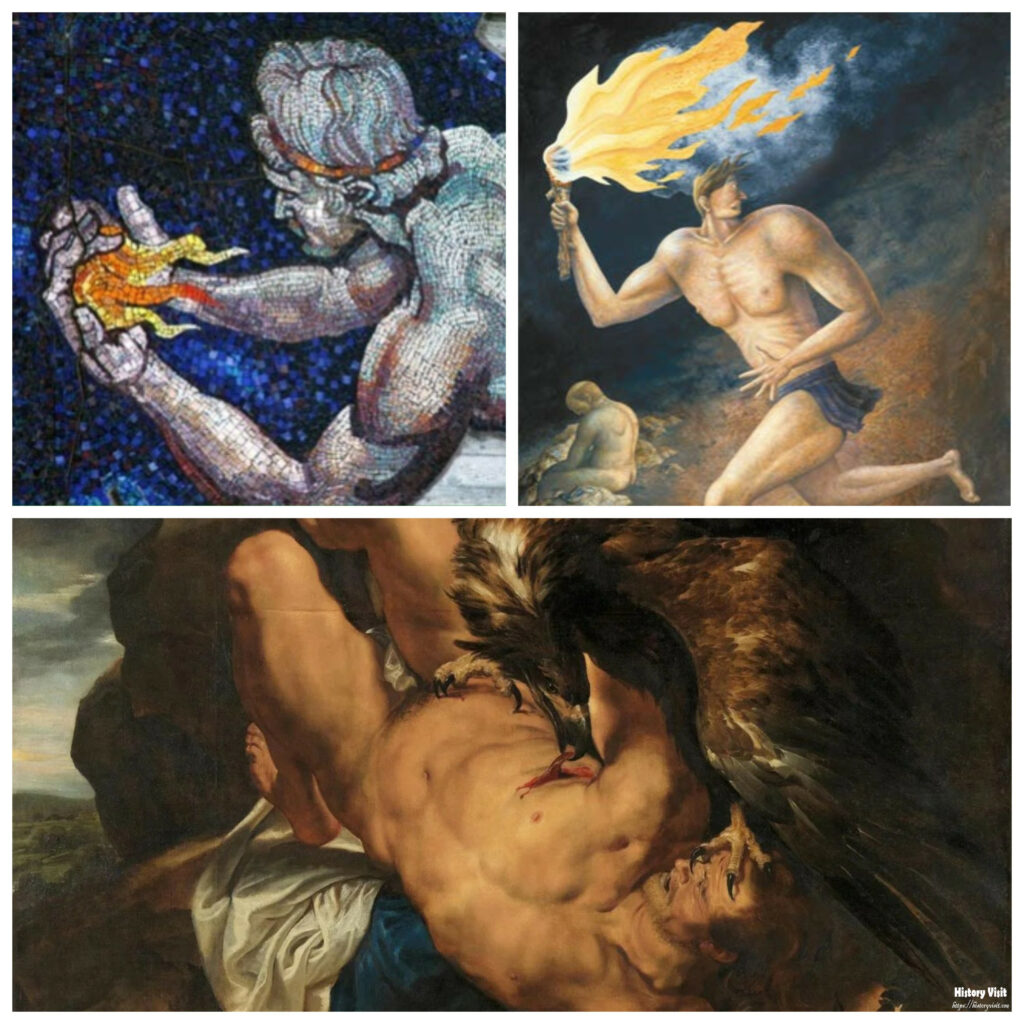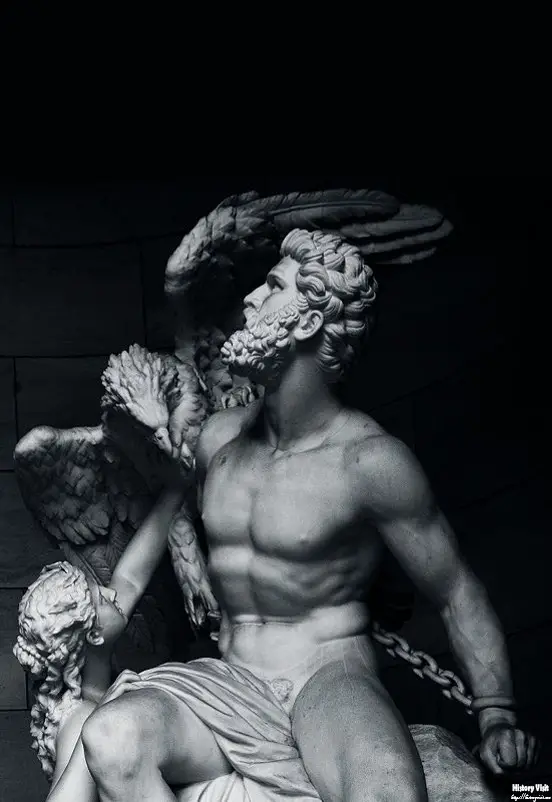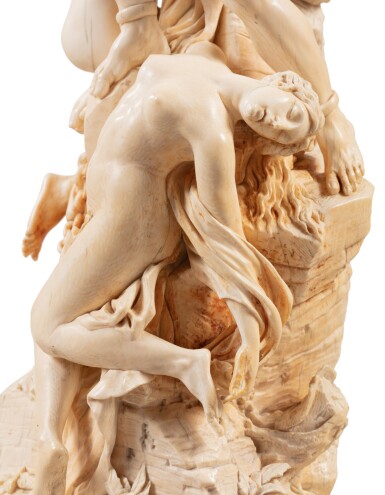Greek Myths: The Story Of Prometheus and Oceanids

Introduction
Greek myths have inspired countless works of art. Among these is “Prometheus Bound and the Oceanids” by Eduard Müller. Created in 1879, this marble sculpture captures a pivotal moment in Greek mythology.
Prometheus, a Titan, defied Zeus. He stole fire from the gods and gave it to humans. His punishment was severe. Müller’s sculpture depicts Prometheus bound to a rock, visited by the Oceanids, sea nymphs who mourn his fate.
The sculpture is a masterpiece of 19th-century art. It combines powerful storytelling with exquisite craftsmanship. By examining this work, we gain insights into both Greek myths and Müller’s artistic vision.
The Story of Prometheus in Greek Myths

Prometheus is a key figure in Greek myths. He was a Titan who sided with Zeus against the other Titans. However, his greatest act was defying Zeus to benefit humanity.
Prometheus stole fire from Olympus. He gave it to humans, enabling them to advance civilization. This act of rebellion had dire consequences. Zeus, angered by Prometheus’ defiance, sentenced him to eternal torment.
Prometheus was bound to a rock in the Caucasus Mountains. Each day, an eagle would devour his liver. Each night, it would regenerate. This cycle of torment was intended to last forever. The Oceanids, daughters of the Titan Oceanus, visited him. They offered comfort and lamented his fate.
This story embodies themes of sacrifice, defiance, and suffering. Prometheus’ enduring pain reflects the price of challenging divine authority. It also underscores the Titan’s compassion and commitment to humanity.
Eduard Müller: The Sculptor
Eduard Müller was a prominent German sculptor. Born in 1828, he studied at the Berlin Academy of Arts. His works often depicted classical and mythological themes. Müller’s skill and attention to detail made him a celebrated artist of his time.
“Prometheus Bound and the Oceanids” is one of Müller’s masterpieces. He created it in 1879, capturing the tragic beauty of the myth. The sculpture reflects Müller’s deep understanding of Greek myths and his ability to convey emotion through marble.
Müller was influenced by the Romantic movement. This movement emphasized emotion, nature, and individualism. His work often explored the tension between human suffering and divine will. Müller’s sculptures are characterized by their dynamic compositions and expressive details.
His portrayal of Prometheus is both powerful and poignant. The agony of the Titan is palpable, yet there is a sense of dignity in his suffering. The Oceanids, with their graceful forms, add a layer of compassion and sorrow. Müller’s ability to capture these complex emotions is a testament to his artistic prowess.
Analysis of the Sculpture

“Prometheus Bound and the Oceanids” is a marble sculpture. It stands as a testament to Müller’s craftsmanship. The composition is dynamic, with Prometheus as the central figure. His body is contorted in pain, yet his face shows resilience.
The Oceanids surround Prometheus, their forms delicate and ethereal. They lean towards him, their expressions filled with sorrow. The contrast between Prometheus’ rugged physique and the Oceanids’ grace highlights the themes of suffering and compassion.
Müller’s attention to detail is evident in the intricate carving of the figures. The texture of Prometheus’ skin, the flowing hair of the Oceanids, and the jagged rock all add depth to the sculpture. The use of marble enhances the sense of permanence and timelessness.
The sculpture invites viewers to reflect on the story of Prometheus. It captures the Titan’s enduring pain and the Oceanids’ empathy. The interplay of light and shadow on the marble brings the scene to life. Müller’s work transcends mere representation, offering a profound commentary on human suffering and divine retribution.
The Themes in Greek Myths
Greek myths often explore themes of power, rebellion, and punishment. The story of Prometheus is a prime example. His defiance of Zeus and subsequent punishment highlight the tension between gods and mortals.
Prometheus’ gift of fire symbolizes knowledge and progress. His suffering represents the cost of such advancements. The Oceanids’ presence in the myth adds a dimension of compassion. Their sorrow contrasts with Zeus’s harsh punishment, emphasizing the complexity of divine justice.
These themes are universal and timeless. They resonate with human experiences of struggle, sacrifice, and empathy. Greek myths use these stories to convey moral and philosophical lessons. The story of Prometheus continues to inspire discussions about the nature of power and resistance.
Müller’s sculpture captures these themes effectively. The physical agony of Prometheus and the emotional anguish of the Oceanids are vividly portrayed. The sculpture serves as a visual representation of the deeper meanings embedded in Greek myths.
The Role of Fire in Greek Myths
Fire holds significant symbolic value in Greek myths. For Prometheus, fire represents knowledge, enlightenment, and civilization. By stealing fire from the gods, Prometheus enabled humanity to progress and thrive.
This act of giving fire to humans was both a gift and a transgression. It challenged the authority of Zeus and the divine order. Fire, therefore, symbolizes both empowerment and rebellion.
In Greek myths, fire is also a source of life and destruction. It can illuminate and warm, but also burn and devastate. This dual nature reflects the complex relationship between humans and the divine. Prometheus’ gift of fire underscores this ambivalence.
Müller’s depiction of Prometheus emphasizes the significance of fire. The Titan’s torment is a direct result of his act of giving fire to humanity. The sculpture captures the duality of fire as both a symbol of progress and a cause of suffering. This duality is central to the themes of Greek myths.
The Influence of Romanticism
The Romantic movement greatly influenced Eduard Müller’s work. Romanticism emphasized emotion, individualism, and the sublime. It often explored themes of nature, suffering, and heroism. These elements are evident in Müller’s portrayal of Prometheus and the Oceanids.
Romanticism sought to capture the depth of human experience. Müller’s sculpture embodies this by depicting the intense emotions of Prometheus and the Oceanids. The agony of the Titan and the sorrow of the nymphs are rendered with great sensitivity.
The movement also valued the sublime, the awe-inspiring beauty that transcends ordinary experience. Müller’s sculpture achieves this through its dramatic composition and intricate details. The contrast between the rugged rock and the delicate forms of the Oceanids creates a sense of awe.
Müller’s work reflects the Romantic ideal of the heroic individual. Prometheus, despite his suffering, is portrayed with dignity and strength. His defiance and sacrifice align with the Romantic celebration of the individual’s struggle against greater forces. This influence of Romanticism enriches the interpretation of Müller’s sculpture.
The Oceanids: Symbols of Compassion

In Greek myths, the Oceanids are sea nymphs, daughters of the Titan Oceanus. They represent the nurturing and compassionate aspects of nature. In the story of Prometheus, the Oceanids visit him in his torment, offering solace.
The presence of the Oceanids in Müller’s sculpture adds a layer of emotional depth. Their sorrowful expressions and graceful forms contrast with Prometheus’ agony. They symbolize empathy and compassion in the face of suffering.

The Oceanids’ visit to Prometheus highlights the themes of solidarity and empathy. Despite their divine nature, they feel and express sorrow for Prometheus’ plight. This connection between divine beings and mortal emotions is a recurring theme in Greek myths.
Müller’s depiction of the Oceanids emphasizes their role as symbols of compassion. Their presence softens the harshness of Prometheus’ punishment. The sculpture thus conveys a message of empathy and shared suffering. The Oceanids’ compassion stands in stark contrast to Zeus’s retribution, adding complexity to the narrative.
Conclusion

Greek myths have inspired artists for centuries. Eduard Müller’s “Prometheus Bound and the Oceanids” is a testament to this enduring influence. The sculpture captures the essence of the myth with remarkable skill and emotional depth.
Prometheus’ story is one of defiance, sacrifice, and suffering. Müller’s portrayal emphasizes these themes, bringing the myth to life. The presence of the Oceanids adds a dimension of compassion and empathy, enriching the narrative.
Müller’s work reflects the Romantic ideals of emotion, individualism, and the sublime. His sculpture invites viewers to reflect on the deeper meanings of Greek myths. The dynamic composition and intricate details make it a masterpiece of 19th-century art.
In conclusion, “Prometheus Bound and the Oceanids” is more than a sculpture. It is a visual exploration of the themes and emotions in Greek myths. Müller’s work continues to inspire and captivate, a testament to the timeless power of myth and art.


